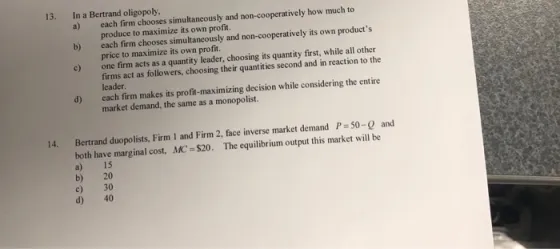Answered step by step
Verified Expert Solution
Question
1 Approved Answer
13. 14. In a Bertrand oligopoly, a) b) c) d) each firm chooses simultaneously and non-cooperatively how much to produce to maximize its own

13. 14. In a Bertrand oligopoly, a) b) c) d) each firm chooses simultaneously and non-cooperatively how much to produce to maximize its own profit. each firm chooses simultaneously and non-cooperatively its own product's price to maximize its own profit. one firm acts as a quantity leader, choosing its quantity first, while all other firms act as followers, choosing their quantities second and in reaction to the leader. c) d) cach firm makes its profit-maximizing decision while considering the entire market demand, the same as a monopolist. Bertrand duopolists, Firm 1 and Firm 2, face inverse market demand P-50-Q and both have marginal cost, MC-$20. The equilibrium output this market will be a) 15 b) 20 30 40
Step by Step Solution
There are 3 Steps involved in it
Step: 1
Answer In a Bertrand duopoly each firm chooses its p...
Get Instant Access to Expert-Tailored Solutions
See step-by-step solutions with expert insights and AI powered tools for academic success
Step: 2

Step: 3

Ace Your Homework with AI
Get the answers you need in no time with our AI-driven, step-by-step assistance
Get Started


